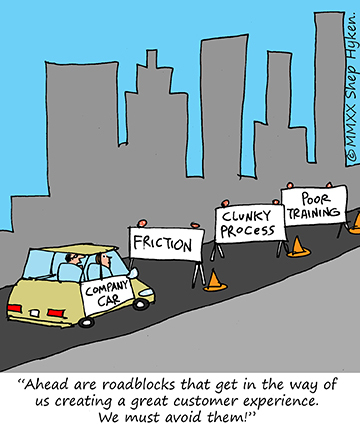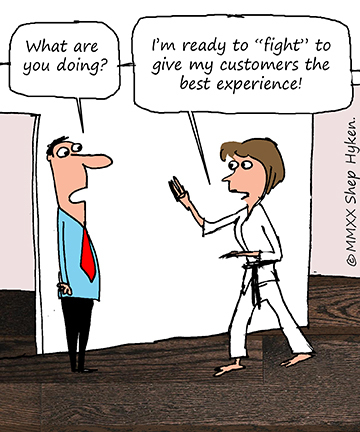Shep Hyken's Blog, page 101
August 5, 2020
How to Avoid Roadblocks to Great Customer Service
What gets in the way of creating a great customer service experience for you and/or your organization?
Is it a process that is clunky, inconvenient and difficult for the customer? Is it people who aren’t properly trained or don’t have the right people skills? It’s easy to ask yourself these questions and self-diagnose your organization, but have you ever asked your people?
That’s exactly what my friend and client, Diane Kniowski, did. Diane is president and regional general manager at Univision. As she moved into this role, she realized the opportunities that would come from providing a better customer experience. The question she asked her team was simple:
If I can remove one roadblock that gets in the way of you doing your best work, what would it be?
While this question was general, it focused on what was getting in the way of success for both the employees and their customers. Her team came back with their answers and consolidated them into 26 areas of opportunity. To date, 25 of those original 26 areas have been eliminated. I say “original 26” because as some of these “roadblocks” were eliminated, new ones were discovered. This exercise, as simple as it sounds, was her way of creating a process improvement initiative that has been wildly successful.
This is similar to an exercise that we do in our customer service workshops. We ask participants to identify the problems and complaints they hear most from both internal and external customers. We add one extra question: “How often does this happen?” We list them all, vote on the top three, and then have a team discussion on how to eliminate or mitigate these problems and complaints.
Here is something interesting related to the “how often” question in our workshops. When someone says, “It happens all the time,” I ask, “Why?” Why hasn’t anyone done anything to at least reduce it from happening “all the time”? This is just common sense. Unfortunately, when you’re in the middle of your work, you don’t or can’t always take the time to step back and analyze certain situations.
What responses you get from Diane’s question or our workshop exercise will vary. Some answers will be major “aha!” opportunities, while others will seem trivial and unimportant. All must be considered, and nobody’s issue should be casually dismissed without a good reason as to why it won’t be pursued.
So, what are you waiting for? Sit down with your team and find your roadblocks to more success. Once these roadblocks and problems start to get eliminated, you’ll be amazed at how other issues start to resolve themselves. This translates into a better experience for both employees and your customers.
Shep Hyken is a customer service expert, keynote speaker, and New York Times bestselling business author. For information, contact 314-692-2200 or www.hyken.com. For information on The Customer Focus™ customer service training programs, go to www.thecustomerfocus.com. Follow on Twitter: @Hyken
(Copyright © MMXX, Shep Hyken)
The post How to Avoid Roadblocks to Great Customer Service appeared first on Shep Hyken.
August 4, 2020
Amazing Business Radio: Andy MacMillan
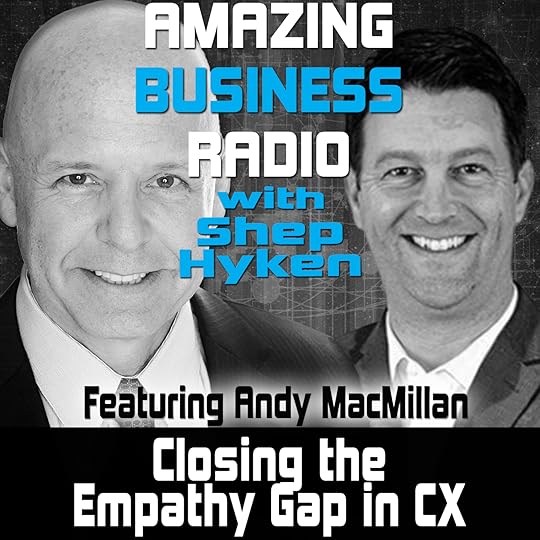
Closing the Empathy Gap in CX
How to Balance Technology with the Human-to-Human Customer Connection
Shep Hyken interviews Andy MacMillan, CEO of UserTesting. They discuss strategies for building a customer-centric culture by balancing empathy and human connection with digitization and technology.








Top Takeaways:
Many companies will do “functional testing” to make sure their products work, but leave out “user testing” to ensure that their customers are having a good experience with their product.
Brands must remember that they not only sell products and services, but experiences. As much time and effort should be put into making sure the experience is a good one.
Companies build brand loyalty, not technology loyalty. Whether your touchpoints are digital or in person, there must be a personal element of the brand at each one.
Though technologies have changed and improved, customer service and experience have remained the same. Nothing has really changed. Customers still want a quick and easy resolution to their problem—and companies want to make their customers happy and get them to come back.
You can’t have a customer-centric culture without putting actual customers at the center of your business. Do not replace customers with data or technology, or your company will suffer in the long run.
Listen to what your customers are telling you about their experiences with you, your products and your services. They will tell you where friction is and what they want.
Every employee at every level of the organization should come into contact with the customer and listen to their feedback. This will foster empathy and create a more customer-focused culture. Leadership must model this.
Quotes:
“If you want to have a customer-centric business model, you have to have a customer at the center of that business model. Technology does not replace that. Data is great, but it is in no way a way to replace actually building empathy with your customer.”
“Know what your brand identity is, not just as you perceive it but as your customers perceive it.”
“None of us, as customers, want to be treated like a number. Yet how many companies do all their customer work by treating everyone like numbers? If you want to break out of that cycle, go talk to some actual customers.”
About:
Andy MacMillan is the CEO of UserTesting and a former product executive at Oracle and Salesforce with 20 years of enterprise SaaS experience. He helps companies become more customer-centric.
Shep Hyken is a customer service and experience expert, New York Times bestselling author, award-winning keynote speaker, and your host of Amazing Business Radio.
The post Amazing Business Radio: Andy MacMillan appeared first on Shep Hyken.
August 3, 2020
5 Top Customer Service Articles For the Week of August 3, 2020
Each week I read a number of customer service and customer experience articles from various resources. Here are my top five picks from last week. I have added my comment about each article and would like to hear what you think too.
Personalization and Customer Experience Strategies for Success by Larisa Bedgood
(Business2Community) Personalized customer experiences are now at the center of all marketing initiatives. Brands are competing on customer experience and a recent Gartner survey shows that 81% of marketing leaders say they expect to be competing mostly or completely on the basis of customer experience.
My Comment: Here’s an article that is filled with stats and facts to make the case for delivering a good customer experience that is followed by some excellent takeaways and “how to’s” create a better, more personalized customer experience. Companies that can deliver on personalization are able to deliver value that makes price less relevant and fosters return business.
5 On the Fly Customer Experience Tips During-A Time of Uncertainty by Michael McNichols
(Smarter CX) Oracle CX Marketing has kicked off season 2 of “On the Fly”—a video series with small, 2-minutes-or-less bites of marketing tips, advice, and training from marketing experts.
My Comment: Smart CX (from Oracle) has been putting out great content. Here are five customer experience and marketing tips to consider during the uncertain times we are experiencing today. If you like these, be sure to click on the YouTube playlist link (here it is) to watch the videos that these tips are based on. Actually, there are quite a few videos with these short tips. So, happy reading and viewing!
Top customer service considerations for retailers in a post-COVID world by Jerry Cambell
(Retail Dive) It’s no surprise to anyone that retailers have been impacted by coronavirus shutdowns, not only because of the closures but due to an influx in customer service requests. One study found that customer support requests for sectors including retail and e-commerce have seen the highest increase since late February 2020 — up an average of 48%.
My Comment: Some of the best lessons are from those who not only teach, but those who also “do.” Jerry Campbell is head of CX for 7-Eleven, a brand we all know and one that has been around since the 1920s and survives and thrives in good times and bad. Campbell shares insights that all businesses, not just retailers, can relate to.
People, Business and the Pandemic – Measuring the Long-Term Impact of COVID-19 [An Infographic] by Dhawal Kumar
(Freshdesk) We conducted several polls across various channels and asked our audiences some crucial questions about the customer-business relationship in the new normal.
My Comment: Freshdesk has created an infographic to support several polls about doing business in today’s new business environment. While the stats and findings (the numbers) may not be specific to your business, the concepts we can learn from them are relevant to any business and industry.
The Era Of The Conscientious Consumer: What Younger Consumers Want From Your Brand by Matt Wujciak
(CCW) In the era of Uber Eats, Apple Pay, and Zoom, modern consumers are finding themselves in an exponentially changing environment, adopting new communication and purchasing behaviors as a result of shifting societal norms – many of which will become more permanent, many of which won’t.
My Comment: Forget that I’m quoted in the article, this is an important topic for all of us. We are entering into an era where our customer’s needs and buying habits are changing, especially those of “younger consumers,” identified as Gen Z and Millennials. When you’re in crisis mode (as we have been), the personality of a company becomes magnified, and the research shows that younger generations have the largest magnifying glass.
 Shep Hyken is a customer service expert, professional speaker and New York Times bestselling business author. For information on The Customer Focus™ customer service training programs go to www.TheCustomerFocus.com. Follow on Twitter: @Hyken
Shep Hyken is a customer service expert, professional speaker and New York Times bestselling business author. For information on The Customer Focus™ customer service training programs go to www.TheCustomerFocus.com. Follow on Twitter: @Hyken
The post 5 Top Customer Service Articles For the Week of August 3, 2020 appeared first on Shep Hyken.
July 31, 2020
Guest Post: Combine Customer Service and Customer Experience to Grow Your Business
This week we feature an article by Ashwini Dave , a digital marketing expert at Acquire. She explains the difference between customer service and customer experience and shares how implementing both into your business creates success.
Customer experience and customer service are often used interchangeably and are the buzzwords for businesses in the age of instant gratuity. While they are not the same thing, they do happen to be related.
According to a recent study, it was found that as much as 86% of buyers were willing to pay more for better customer experience. Not to mention that companies excelling at customer experience generate revenues to the order of 4-8% higher than their competitors. But, in the meantime, what happens to customer service? And how do you differentiate between the two?
Customer Service and Customer Experience: How They Are Different
Customer service takes precedence. But so does customer experience. So, how do companies decide which one to focus on?
Customer Service
“You’ll never have a product or price advantage again. They can be too easily duplicated. But a strong customer service culture cannot be copied.”
– Jerry Fritz, Director of Management Institute, University of Wisconsin
Good customer service can be aiding a customer with product queries during their buying journey, troubleshooting their issues, and making sure they had a stellar buying experience.
Customer Experience
Customer experience, on the other hand, means the overall customer journey across various touchpoints and involves every interaction the customer has with the business.
It involves all the different ways that you, as a brand, interact with the customer and constitutes of three main components:
Customer service
Technology
Design
4 Ways to Combine Customer Service and Customer Experience to Grow Your Business
Here, we will look at four ways to combine the two disparate yet interconnected concepts of customer service and customer experience to help you get started.
1. Unlock Information with Co-Browsing
Co-browsing helps unlock a higher degree of information by combining real-time experience and human relationships to provide a personalized customer experience. In fact, co-browsing-aided support conversations are so successful that satisfaction ratings from a recent Forbes report reflected a high of 89.3%!
Let’s take Acquire, for example. Acquire’s co-browsing feature helps you show the customer how to use your product instead of telling them. By controlling the tab on which the user is asking for help, you can bring in more interactivity and humanize customer relationships. Indeed, it results in higher customer satisfaction, as 78% of customers said they were better served through co-browsing as opposed to 47% for self-service support.
Not only that, but co-browsing is also a fantastic way to spot issues with your UX. It is a great growth hacking tool for companies with continually evolving standards as it merges CX and customer service to help the customer understand your novel offerings, all the while increasing upselling opportunities and shortening the sales cycle.
2. Exploit AI-Powered Tools to Automate Common Queries
After unlocking and gathering information, it’s time to make use of the insight you have gained to automate regular queries. Automating routine questions and deploying this information through a chatbot can not only enable personalization but also answer up to 80% of routine questions, ultimately helping businesses save 30% in customer support costs.
Amtrak, a passenger railroad service, realized how they could use chatbots to hack growth and provide a better customer experience to customers as a result. A huge organization, Amtrak’s website, was getting almost 375,000 visitors each day, and managing customer interactions was getting difficult.
Using an advanced AI chat platform, Amtrak created ‘Ask Julie,’ a chatbot to provide customer service by helping visitors find answers without having to call the support team. However, Julie goes one step further as it combines effective CX with customer service to help travelers book their rail travel and assist them by pre-filling forms. As Julie’s usage grew by 50%, Amtrak saved $1 million in customer service costs and realized an 800% ROI.
3. Give Personalization with Live Chat
Live chat can take personalization one notch higher by enabling your support team to interact with customers in real-time during the purchase process. Prospects love it too, with 75% of them preferring to chat in real-time as it helps them get the answers they need quickly.
A fantastic example of using live chat as a growth hacking technique to provide better customer service is the VPN provider, PureVPN. They were facing the challenge of increasing sales and improving overall customer satisfaction on their website.
Wanting to efficiently assist their expanding customer base, PureVPN struck gold when they decided to introduce live chat as a solution by making it one of their main communication channels. This helped them use pre-made answers to routine questions and consequently provide improved customer service.
Their users delighted in having a 24/7 live chat option that boosted their product experience and also encouraged them to chat courtesy of automatic and personal greetings. This helped PureVPN increase overall sales by 15-20% through live chat interactions and boosted customer satisfaction by a further 34% as the overall customer satisfaction recorded a high of 94%.
4. Measure Customer Satisfaction Beyond Traditional C-SAT Scores
As the standard of retail customer care has become more homogeneous, the C-SAT score isn’t as relevant with the Net Promoter Score (NPS) assuming the all-important role today. A person’s willingness to promote a product or a service forms the basis of NPS. According to Nielsen, 83% of customers trust suggestions from people they know, while 66% of them would trust opinions from other consumers online.
InVision, the world’s foremost CX designer, can vouch for this as it used NPS surveys to keep a pulse on customer sentiment and pinpoint the areas where they could improve their platform. The Manager of User Research operations at InVision, Lindsey Redinger, said that:
“The most important piece of capturing NPS is the ability to solicit that qualitative feedback from those people who complete the survey.”
The NPS data-enabled InVision’s team to keep tabs on customer perception in addition to helping them find out the changes they had to introduce to improve the product experience for customers. This helped them provide better customer service and enhance the overall CX by enabling better sales conversations.
Get Aware
Customer service and customer experience aren’t interchangeable, but they are ultimately all about customer satisfaction and are equally important devices of doing so. The key difference between both of them is that customer experience makes up the entirety of the customer journey, along with customer service.
Both are crucial to an organization’s success, yet the line that separates them is almost diaphanous.
Ashwini Dave is passionate about business, entrepreneurship, e-commerce, emerging technology and digital marketing. She is working with Acquire as a digital marketing expert. She is a free soul and adventurous scholar who spends her free time with herself, loved once, music, as well as watching & playing sports.
F
 or more articles from Shep Hyken and his guest contributors go to customerserviceblog.com.
or more articles from Shep Hyken and his guest contributors go to customerserviceblog.com.
Read Shep’s latest Forbes article: Now More Than Ever, Customers Want To Trust Companies They Do Business With
The post Guest Post: Combine Customer Service and Customer Experience to Grow Your Business appeared first on Shep Hyken.
July 29, 2020
A Boring Customer Service Experience—That’s What Our Customers Want
Call me boring, but I want the same thing every time—at least when it comes to customer experience.
I want it to be good. I want it to be consistent. I want to predict the experience I’m going to have with the people and places I do business with. If you ask the CEO of a big company or the owner of a small business, I bet they would say the same.
We want our customers to always have a good experience with us—one they can count on always happening every time they do business with us. We want them to find that our people are always knowledgeable, always helpful, always friendly and always respond quickly. We want our products to always work and do what they are supposed to. If, for some reason, there is a problem, we want our customers to know they can always count on us to resolve it for them.
Sounds monotonous, doesn’t it? It is, but this is good monotony—the kind of monotony our customers like. This is not about a boring experience. It is about being so focused on a consistent and predictable experience that we hear the same feedback over and over again. The same thing happening over and over? Some might call that boring, but we all know it’s not.
Think about why you like to do business with your favorite companies. By the way, it can be any type of company from any industry—from retail to hospitality to manufacturing and beyond. When you start to analyze why you like them, I’ll bet part of the answer is that you are able to predict the outcome. You have trust in the company and confidence in receiving a similar, positive experience every time. This can be summed up in one word: always.
There is a lot that goes into making something always happen. It’s hiring the right employee for the job, especially for the front line. It’s about the proper training to create the consistent experience. (By the way, that training must be ongoing and consistent, too.) It’s about a process that is proven and that people follow.
The bottom line is this: our customers may not know it, but they love boring. They love monotony—at least, as it applies to the customer experience. So be bold with your marketing, your products and your innovations, but be boring when it comes to customer service and experience.
Shep Hyken is a customer service expert, keynote speaker, and New York Times bestselling business author. For information, contact 314-692-2200 or www.hyken.com. For information on The Customer Focus™ customer service training programs, go to www.thecustomerfocus.com. Follow on Twitter: @Hyken
(Copyright © MMXX, Shep Hyken)
The post A Boring Customer Service Experience—That’s What Our Customers Want appeared first on Shep Hyken.
July 28, 2020
Amazing Business Radio: Chuck Surack
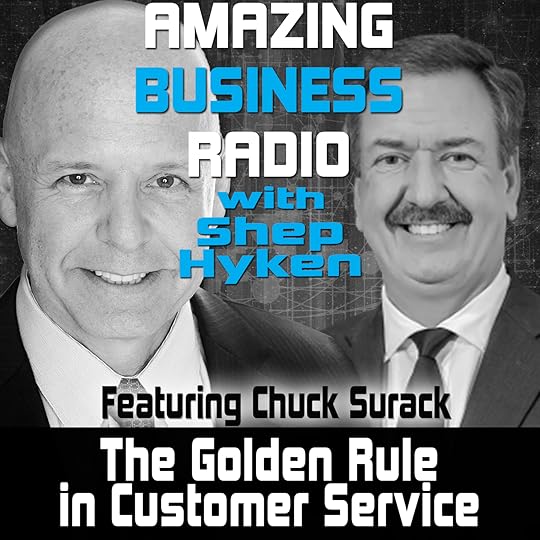
The Golden Rule in Customer Service
Empowering Employees to Take Care of the Customer—Always
Shep Hyken interviews Chuck Surack, Founder and CEO of Sweetwater. They discuss strategies for building a culture of amazing customer service and experience.








Top Takeaways:
Good customer service and experience is a competitive advantage; it sets your company apart from competitors.
Empower your employees to do whatever it takes to take care of the customer, not just for today or one transaction, but forever.
When you focus on taking care of the customer, the rest of your business has a way of working itself out. Besides, taking care of the customer is simply the right thing to do.
Start creating an exceptional customer experience and company culture by hiring the right talent from the beginning. Look for people the with education and experience necessary, but more importantly, look for people who have “fire in the belly” for taking care of customers.
Once you’ve hired the right people, you must train them to the products, processes, values and culture of your organization. This training should not be a one-time event; it must be ongoing for the rest of their career!
Don’t punish the majority of your customers or employees for the mistakes or wrongdoings of a few.
Empower your employees and then TRUST that they will do the right thing. If you do this right, they will never have to say, “Let me check with my manager.”
Do the right thing for the customer, even if the issue isn’t your fault. Treat the customer how you would want to be treated—as a fellow human being.
When dealing with customers, remember that you don’t know what’s going on in their lives, either. Always look for the good in everyone.
Quotes:
“I empower all my employees to do whatever they need to do to take care of the customer, not just for this transaction, but forever.”
“Everyone in the company, from the receptionist to the warehouse folks and everywhere in between, has the ability to either add credibility or take credibility away from the brand you’ve worked so hard for.”
“Everyone makes mistakes. We’re human. It’s how you handle those mistakes that really sets you apart and makes you different.”
About:
Chuck Surack is the Founder and CEO of Sweetwater in addition to owning ten other businesses. He is a frequent speaker and mentor and mentor on issues such as entrepreneurship, quality customer service and the pursuit of excellence.
Shep Hyken is a customer service and experience expert, New York Times bestselling author, award-winning keynote speaker, and your host of Amazing Business Radio.
The post Amazing Business Radio: Chuck Surack appeared first on Shep Hyken.
July 27, 2020
5 Top Customer Service Articles For the Week of July 27, 2020
Each week I read a number of customer service and customer experience articles from various resources. Here are my top five picks from last week. I have added my comment about each article and would like to hear what you think too.
Traditional vs. frictionless payments: Will customers trade security for convenience? by Pat Shea
(Retail Customer Experience) Since the start of the COVID-19 pandemic, many consumers, especially those who never shopped online before, turned to online payments out of necessity for everything from groceries to gifts. A major concern of these consumers was, and is, data security. Is their information safe online? How is it being protected?
My Comment: Today’s payment process, especially in retail, is headed toward a cashless system. COVID-19 had made touchless payment a popular way to avoid having to touch anything. It was predicted many years ago that our society would eventually go cashless. Regardless of the type of business you’re in, it’s time to understand what that will look like for you. This article is a good place to start.
How to Gain Customer Loyalty During a Recession by Dana Kachan
(CustomerThink) Building customer loyalty is an essential part of digital marketing for new normal that can do wonders with your conversions.
My Comment: COVID-19 caused the world to go into economic turmoil. When that happens, companies we do business with can lose confidence. It’s our job to create confidence. That’s what our customers want in the places/businesses they decide to spend money on. I read this list and there are both timeless and timely suggestions.
Rethinking retail in the wake of Covid-19 by Sachin Dev Duggal
(Retail Customer Experience) In what felt like an overnight shift, the way that small businesses traditionally interacted with their customers stopped, changed or morphed. Among those most vulnerable are the smaller retailers without an online presence that depend on their customers to walk through their doors.
My Comment: Okay… Another article about how to manage Post-COVID-19 business, but what caught my eye was that one of the strategies is about the subscription model. If you haven’t already created a subscription model for your business, it’s not too late. Even if the COVID-19 crisis had never happened, the subscription model is a powerful way to do business.
Journey mapping in the customer experience by Chris Beaudin
(Retail Customer Experience) Just like a buyer persona identifies who you are targeting to purchase your product, the journey map outlines the experience that persona will encounter as they proceed to a purchase.
My Comment: I’m a big fan of journey mapping. If you’ve been following my work – and even this weekly roundup – that shouldn’t be a surprise. If you haven’t gone through the journey map exercise, this article will get you started.
Two Tools To Improve Your Internal And External Customer Experience by Tracy Kemp
(Forbes) The idea of putting the customer first is not a new concept. Today, it is understood that it is important to provide exceptional service to your external customers in order for businesses to be successful. However, it is equally important to provide an excellent experience to your internal customers: your employees.
My Comment: And while we’re on the topic of journey maps (the fourth article in this week’s roundup), consider going beyond what customers experience and look at the employee journey map. The customer experience is a result of what’s happening on the inside with employees, so it makes total sense to focus on them as well.
 Shep Hyken is a customer service expert, professional speaker and New York Times bestselling business author. For information on The Customer Focus™ customer service training programs go to www.TheCustomerFocus.com. Follow on Twitter: @Hyken
Shep Hyken is a customer service expert, professional speaker and New York Times bestselling business author. For information on The Customer Focus™ customer service training programs go to www.TheCustomerFocus.com. Follow on Twitter: @Hyken
The post 5 Top Customer Service Articles For the Week of July 27, 2020 appeared first on Shep Hyken.
July 24, 2020
Guest Post: How to Attract New Business During COVID-19
This week we feature an article by Derek Goodman, entrepreneur and creator of Inbizability. He shares some tips on how to gain new customers during difficult economic situations, such as the COVID-19 pandemic.
Just a few months ago, your business was as busy as ever. But now, with offices closed and business forced online due to COVID-19, many companies have watched work dry up. Unless you have the cash reserves to wait out the crisis — a luxury few businesses can afford — finding new clients is a priority for business continuity. But before you can attract clients, you need to adapt your strategy to the times.
Use digital channels to grow your audience
Digital businesses are doing better during the pandemic. While it’s not too late to start your digital transformation, a strategic approach pays off. According to McKinsey, companies that take a bold and tightly integrated approach to digital transformations are more likely to succeed. An end-to-end approach that includes remote working, data security, and digital marketing ensures that you can not only find clients, but you’re prepared to serve them too.
Fix online business listings: Before new clients can patronize your business, they need to find it. Ensure Google My Business listings are up-to-date and reflect coronavirus-related changes.
Update your website: Your website should also communicate loud and clear how your company is adapting to the pandemic. Include a banner with a link to information on lead times so new clients can easily find the information they need and add self-service tools to reduce customer service backlogs.
Spend digital marketing dollars wisely: Social media marketing has been critical for B2C companies during the pandemic, whereas B2B organizations are turning to online events and content creation to maintain visibility.
Commit to remote work: Employees also need to be prepared to meet client needs remotely. Instead of viewing remote work as a temporary solution, equip telecommuters with the software and technology they need to reach full productivity at home.
Invest in security: Remote work and e-commerce present cybersecurity concerns. Due to the high cost of cyberattacks — as well as the impact on an organization’s reputation — upgrading cybersecurity infrastructure is well worth the investment.
Adapt your business model to changing needs
Companies aren’t just changing how they do business. They’re also changing the type of business they do. The top economic performers in the COVID marketplace are not only taking analog products and services digital, they’re also creating entirely new offerings to meet client needs during the crisis. As Work-from-Home Depot explains, this isn’t the time to be risk-averse. While strengthening relationships with existing clients is important, so is being innovative and addressing the specific challenges that customers are facing right now.
Consider how your business can adapt its services to meet today’s needs. Can you offer something valuable to people stuck at home, to essential workers, or to other organizations navigating the COVID-19 marketplace? Creativity is key to staying relevant.
Find resources to support your business
Adapting your business may be the best way to ensure continuity, but don’t underestimate the importance of financial support. Even if your organization succeeds in increasing its client load, pivoting costs money. Business grants and loans can provide your business with the resources it needs to handle the increased costs and revenue loss triggered by the COVID-19 crisis.
Government relief programs include the Paycheck Protection Program, Economic Injury Disaster Loans, and SBA Express Bridge Loans. Companies can also tap non-governmental resources like cash grants. While grant awards from non-governmental organizations tend to be smaller, they may be less competitive than federal relief programs.
Keeping your business alive through COVID-19 isn’t a single-pronged approach. In addition to expanding your business’s digital reach, make sure you’re pivoting your business to stay relevant and taking advantage of the resources available to your organization. By preparing your business to not just find, but serve customers, you can turn the clients you attract during the pandemic into loyal customers for years to come.
Derek Goodman is an entrepreneur. He’d always wanted to make his own future, and he knew growing his own business was the only way to do that. He created his site Inbizability , to offer you tips, tricks, and resources so that you realize your business ability and potential now, not later.
F
 or more articles from Shep Hyken and his guest contributors go to customerserviceblog.com.
or more articles from Shep Hyken and his guest contributors go to customerserviceblog.com.
Read Shep’s latest Forbes article: Would Your Customers Recommend You?
The post Guest Post: How to Attract New Business During COVID-19 appeared first on Shep Hyken.
July 22, 2020
Would You Fight to Make Your Customers Happy?
These are the kind of people—and the kind of company—you want to do business with.
First, a little background. I was having a conversation with a colleague and came up with the idea that you shouldn’t have to fight with a company to get your problem resolved or for them to make you happy. They should want to make you happy.
Just a couple days later I saw this idea in action, but with a twist. I was on a customer support call with a software company and their rep said, “I’ll need to talk to my manager. I’m on your side, and I’ll fight to make you happy.”
Did he just say he would fight his manager to make me happy? This is the customer service rep I want to talk to every time I call the company. This is the person I want on my side. This is my “new best friend” at the software company. He doesn’t just want to make me happy. He will fight to make me happy.
This is exactly the kind of person—in any company—I want to talk to whenever I call for help, have a question or even a complaint.
The word “fight” is an interesting one. The official definition—actually, there are two of them, according to Merriam-Webster—is to contend in battle or physical combat, and to put forth a determined effort. When it comes to customer service, I’m in alignment with the second definition. I want it to be the company that fights or makes “a determined effort”—to take care of me!
If I have a problem or a complaint, I shouldn’t have to fight—or make a “determined effort”—with the company to resolve it for me. It’s actually the other way around. They should fight and make that “determined effort” to keep me happy. After all, I represent not just that one sale, but potential future sales. I might also share my experiences with others, which could turn into more sales for them.
If we look at the first definition of fight, which uses the words battle and physical combat, I can see a company stating, “Let’s fight against poor customer service.” That second definition should sum it up for everyone. Bad service has no place in any company. It’s everyone’s responsibility to fight for their customer and make a determined effort to give them the best experience, one that makes them happy and gets them to come back—again and again!
Shep Hyken is a customer service expert, keynote speaker, and New York Times bestselling business author. For information, contact 314-692-2200 or www.hyken.com. For information on The Customer Focus™ customer service training programs, go to www.thecustomerfocus.com. Follow on Twitter: @Hyken
(Copyright © MMXX, Shep Hyken)
The post Would You Fight to Make Your Customers Happy? appeared first on Shep Hyken.
July 21, 2020
Amazing Business Radio: Lenora Billings-Harris
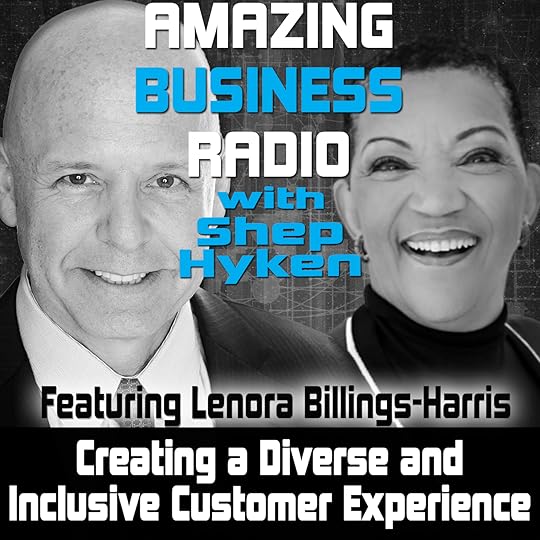
Creating a Diverse and Inclusive Customer Experience
How to Become an Advocate for Change within Your Organization
Shep Hyken interviews Lenora Billings-Harris, an award-winning authority as a diversity strategist, researcher and author. They discuss race and racism within the workplace, and how leaders and employees alike can dismantle biases within their organizations.








Top Takeaways:
Many people assume (wrongly) that diversity is about equal employment opportunity and affirmative action, which are actually government regulations. Diversity is about who’s on your team.
All metrics prove that if diversity and inclusion are part of your company, you will outperform your competitors.
Diversity of thought on your team helps you become more innovative, make more money and ultimately succeed.
You must ensure that your corporate culture is both diverse and inclusive.
It’s important to remember that for many questions and issues related to diversity and inclusion, there is no one absolute right answer.
It’s one thing to have good intentions. However, people cannot read each other’s minds to determine intention; we can only measure the impact our words and actions have.
Racism shows up in the workplace and has a huge impact on both the employee and customer experiences. It is five times harder for Black people to get their foot in the door as it is for white people. It comes down to unconscious bias and microaggressions.
There is a difference between an ally and an advocate. Allies will speak up in the moment if they see something happen. Advocates do this and more; they intentionally disrupt bias and seek multiple ways of breaking down barriers.
In order to enact change within an organization, leaders must become advocates for diversity and inclusion. They must do their personal work to overcome bias (conscious and unconscious) first, then actively advocate for the people in their organizations.
Don’t remain silent. Speak up and take action, even (especially) if you make mistakes along the way. If you want to help, become an advocate.
Quotes:
“Diversity of thought allows you to be more innovative and make more money. All the business metrics say that if you have diversity and inclusion in your company, you’ll do better than your competitors.”
“The next step after diversity is inclusion. If you have diversity without a culture that includes people who are different, then you’re still going to make the same mistakes.”
“We’re all imperfect and we’re going to make mistakes. The point is to not wait until you’re perfect, because that’s not going to happen. Lean into the discomfort. If you’re coming from a place of good intention, people will understand even when you mess up.”
About:
Lenora Billings-Harris is an award-winning author, thought leader and international speaker in the areas of inclusion, diversity and unconscious bias. She is a Certified Professional Speaker (CSP) and a Council of Peers Award of Excellence (CPAE) Speaker Hall of Fame inductee.
Shep Hyken is a customer service and experience expert, New York Times bestselling author, award-winning keynote speaker, and your host of Amazing Business Radio.
The post Amazing Business Radio: Lenora Billings-Harris appeared first on Shep Hyken.

